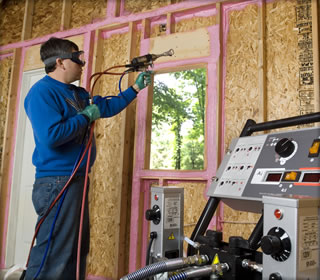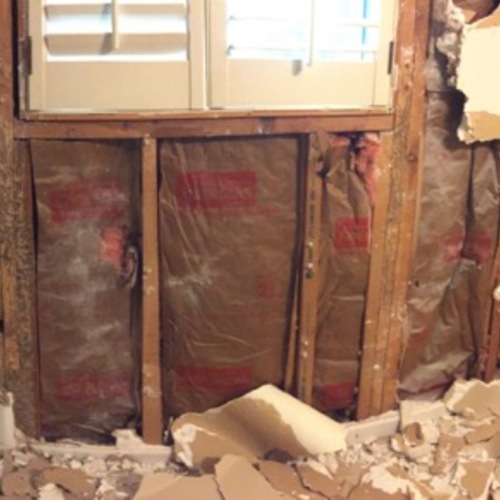
I recently attended an event at the Owens Corning (OC) insulation plant in Fairburn, Ga., about 45 minutes from my house. Being of the geeky sort, I always appreciate the opportunity to see big machines, so the factory tour piqued my interest, although, unfortunately, I was not allowed to take any pictures of the process. As is usual with most industry events, there was some good, some bad, and a little ugly, but overall I considered it a reasonably good use of my time. And as a bonus, I actually learned a few new things while there.
OC assembled about 30 industry people, including builders, representatives from utility companies, the Centers for Disease Control, the National Center for Healthy Housing, the Georgia chapter of the USGBC, Southface, green-building scientists, and some industry hangers-on like myself.
Some interesting facts
To start off the day, OC representatives shared some statistics with us. They were 56th in Newsweek magazine’s list of the top 500 green companies, and they are the largest supplier of glass fiber reinforcement for the wind power industry (this fact came with a PowerPoint slide showing a single turbine blade that looked as big as a commercial passenger jet).
The quick sales pitch was followed by a presentation by Paul Bates of GreenGuard Environmental Institute, a third-party testing organization focusing on air quality. While I am familiar with GreenGuard, their product listings tend toward the commercial market, so I have not dug too deeply into their ratings. My patience got the better of me early in the presentation as Bates was primarily addressing products rather than process, but he did get to the process eventually, and early enough that I didn’t get too rude with him. Some of the interesting factoids I took away—although I have not verified them personally—include:
- New homes can have indoor pollution levels that are more than 1000 times those that are considered safe.
- Computers, printers, and toner cartridges are consistent emitters of VOCs.
- Chrome-plated metal can release heavy metals through skin contact.
- Paints that are listed as having no VOC content can emit VOCs as they dry. (This particular point seemed somewhat self-serving, as GreenGuard specializes in product emissions, but I guess that’s why they provide these presentations.)
- Sunlight interacts with asphalt to create ground-level ozone.
- Over 10 years, childhood asthma rates have increased by 160%.
- Every day 40,000 people miss work due to asthma and 30,000 people have asthma attacks.
- 5,000 people die of asthma every year.
- Poor indoor air quality results in $20 billion in workers compensation and medical costs and $120 billion in litigation costs annually.
Bates sort of backed himself into a corner toward the end when he recommended that indoor air quality be tested annually, but couldn’t provide any good resources for professionals to do the testing, and admitted that the cost of these tests are prohibitively expensive for the residential market. We ended with a good discussion of the value, supply, and demand for services like these.
But why are we here?
The primary purpose of this meeting was to introduce OC’s new insulation system, EnergyComplete, which consists of a spray-applied latex gasket/air seal combined with traditional batt or blown-in fiberglass insulation. While I have seen this product before—and from what I have seen, I am impressed with it—there were many people who were not familiar with it, nor were they fluent in building-science speak, which dominated much of the day.
OC’s biggest selling point is the low toxicity of the sealant, which can be applied without the need for complete personal protection and respirators; nor do other trades need to leave the house, as is the case with most spray foam products. I appreciate the low toxicity of the sealant, and if it and the insulation are both applied correctly, the system should result in a well-sealed and insulated building. But as with all products, the devil is in the details. Allowing various trades to be working in the house while the air sealing is under way could easily have people cutting holes in the building envelope after air sealing is done, creating leaks and thermal bypasses that get missed in the rush to get to drywall.
The last word
Overall, I thought the day with OC was time well spent. They didn’t schedule anything during lunch, so there was plenty of time to network, and most of the attendees took advantage of this opportunity to meet new people and hand out cards. Clearly, the focus was on healthy buildings, which is OC’s big new marketing push as they expand their offerings in the marketplace. I’m willing to give their new product a try. I appreciate the fact that they are raising the bar in home construction and look forward to seeing how the market accepts their new product.
Weekly Newsletter
Get building science and energy efficiency advice, plus special offers, in your inbox.













14 Comments
Insulating value?
Carl--thanks for this post. OC's marketing push has been strong, but I haven't seen much in the way of independent review. Is Energy Complete only a sealant? The sample they sent me had an inch or so of depth, so wondering if it's a viable solutions for rim joists and such where we're looking for both sealing and R-value. And any sense of cost?
Insulating Value
They make no claims of R value for the sealant, I think appropriately. They said that it should cost about 1/2 to 2/3 of a standard spray foam installation, the variation accounting for the regional costs of spray foam. As with any insulation, it's all part of the system and will be prone to poor building design, improper installation, and gaps created after installation, just like everything it is competing with.
"complete" system
I spoke with them via phone a month or so ago when I first ran onto the products and spoke w/a gent who identified himself as a tech person for O_C. He, too, shied away from using the sealant for its insulation value and was (surprise, surprise) pushing fiberglass and, as Carl confirms, low toxicity. That doesn't mean, of course, that it can't be used for insulation, only that it isn't the marketing program at least for now.
I was less impressed by the "technical information" he sent in reponse to my request ... it was only the same marketing generalizations that were (at the time) on the website for consumers ... who they seem to insist by the quality of information available are entirely uninformed.
Be that as it may, it would be lovely if OC (EComplete) and JM (Spider) could get into a price war before I begin my own build project next year. But at this point my $$ would have to go to JM (if I were to choose glass over cellulose) as they at least have some technical data to provide the end user. And of course we have Michael Chandler's endorsement here on GBA.
Thanks, Carl, the fact they were willing to stand up in front of the likes of you at least suggests they are serious, even if being pretty cautious in their first steps. I hope the caution is only the fear of cutting into their sales of glass and not questions about quality in the product.
Joe W..
The System
Joe - To clarify, the sprayed on sealed is only used to provide an air barrier at connections between framing members and joints in sheathing. It still requires fiberglass batts, or preferably blown in batts to fill the framing cavities. Regarding the air quality, at least some, if not all of the OC fiberglass products are Greenguard certified regarding emissions from the in place product.
Thanks again
That clarifies one question I had.
Joe W
energy complete
i believe this has been used on a couple houses in the northwest. none of them were as airtight as the owners/builders had hoped. luckily none were aiming for passivhaus.
I think this is a spray
I think this is a spray applied latex caulk. It requires a spray equipment setup. Dont know if this is propriertary equipment.
I would like to here more details about how it would be used. What are the different application techniques?
Please post costs anyone who has used it
My gut tells me this is a good product that is too expensive for what it really costs to make. All companies are finding it harder to support last years profit and so they work hard to put out new products that gain them back market share and return them to higher profit margins. Capitalism at work.
However...to do the same differently, we just caulked and glued up a frame to seal it and I am sure that we made much more in labor for our efforts and were able to save the customer dearly. Win win for us locally... a loss for the big corp.
Please those that have used this product, post some cost data. Thank you.
Owens Corning Gal
Please reach out to me in regards to questions around Energy Complete. I came to OC last year with a background in zero net energy and healthy design and construction. I can also share with you the specification and UL report. EC also has been tested to maintain it's properties for at least 50 years. Works great in compartmentaization design projects. Can caulk do that? [email protected]
What about unvented roof assemblies?
Just today I am struggling with an issue of how best (and cheaply) to seal the underside of roof OSB decking and the open-web, flat-roofed truss connections. We installed R-10 rigid insulation on top of the decking, but our climate zone says we should have put R-20 if we wanted to fill the 16" cavity solid with blown-in fiberglass and then not vent the assembly, which is what we want to do.
Our inspector has said either seal the underside with foam or tear off the roof and add more rigid, or vent the assembly and negate the value of the R-10 already in place, which means reduced HERS ratings and risk of tax credits going away.
So will this product get the job done cheaper than closed-cell foam and satisfy my inspector?
Response to Kimshanahan
Kimshanahan,
Your inspector is concerned because your OSB roof sheathing is at risk of rotting due to condensation or moisture accumulation during the winter.
OC Energy Complete won't help. The latex goo is for air sealing, not insulating. Air sealing is not your problem.
You'll either have to remove the roofing and thicken the insulation on top of the roof, or else install closed-cell spray foam from the bottom.
blowing agent for XPS
some months ago (1st June) there was an article in the blog here "Avoiding the Global Warming Impact of Insulation" that talked about the use of HFC-134a in XPS.
Since there are some Owens Corning contacts here, how about asking them if HFC-134a is really used in their pink XPS product, and if so how much is used in a 8' x 2' x 2" board (a popular size), and when might they plan to stop using HFC-134a.
What about the hazards of
What about the hazards of fibreglass insulation? I was recently at a seminar where a speaker suggested that the only reason fibreglass was not gold rated as a carcinogen was because the economics of doing so were unworkable. I have also heard other insulation consultants express concern about the safety of fibreglass.
Price of this new product
I have one price so far for average 2000sqft home. $2,000.00 added to the cost of whatever insulation is used.
Still, can anyone else... lots of others post prices???????
Someday Google or someone is going to make construction costs more transparent.
Log in or create an account to post a comment.
Sign up Log in